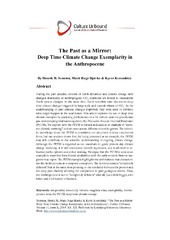| dc.contributor.author | Svensen, Henrik | |
| dc.contributor.author | Bjærke, Marit Ruge | |
| dc.contributor.author | Kverndokk, Kyrre | |
| dc.date.accessioned | 2020-05-08T13:31:27Z | |
| dc.date.available | 2020-05-08T13:31:27Z | |
| dc.date.issued | 2019-09-30 | |
| dc.Published | Svensen H, Bjærke MR, Kverndokk K. The Past as a Mirror: Deep Time Climate Change Exemplarity in the Anthropocene. Culture Unbound. Journal of Current Cultural Research. 2019;11(3-4):330–352 | eng |
| dc.identifier.issn | 2000-1525 | |
| dc.identifier.uri | https://hdl.handle.net/1956/22154 | |
| dc.description.abstract | During the past decades, notions of Earth dynamics and climate change have changed drastically, as anthropogenic CO2-emissions are linked to measurable Earth system changes. At the same time, Earth scientists have discovered deep time climate changes triggered by large scale and natural release of CO2. As the understanding of past climatic changes improved, they were used to envision what might happen in the near future. This article explores the use of deep time climate examples by analyzing publications on a 56-million-year-old greenhouse gas-driven rapid global warming event, the Paleocene-Eocene Thermal Maximum (PETM). We explore how the PETM is framed and used as an example of “extreme climatic warming” in four cases across different scientific genres. The scientific knowledge about the PETM is considered too uncertain to draw conclusions from, but our analysis shows that, by being presented as an example, the PETM may still contribute to the scientific understanding of ongoing climate change. Although the PETM is regarded as too uncertain to guide present day climate change modeling, it is still considered morally significant, and is allowed to influence public opinion and policy making. We argue that the PETM is used as an example in ways that have formal similarities with the early modern historia magistra vitae topos. The PETM example highlights the ambivalence that characterizes the Anthropocene as a temporal conception. The Anthropocene is “completely different”, but at the same time pointing to the similarity between the present and the deep past, thereby allowing for comparison to past geological events. Thus, the Anthropocene is not so “completely different” after all. Just a little bigger, a lot faster, and a lot scarier to humans. | en_US |
| dc.language.iso | eng | eng |
| dc.publisher | Linköping University Electronic Press | eng |
| dc.relation.uri | http://www.cultureunbound.ep.liu.se/advance_access/01/CU_advance_access201909301.pdf | |
| dc.rights | Attribution-NonCommercial CC BY-NC | eng |
| dc.rights.uri | http://creativecommons.org/licenses/by-nc/4.0/ | eng |
| dc.subject | Temporality | eng |
| dc.subject | historicity | eng |
| dc.subject | historia magistra vitae | eng |
| dc.subject | exemplarity | eng |
| dc.subject | Anthropocene time | eng |
| dc.subject | the PETM | eng |
| dc.subject | deep time climate change | eng |
| dc.title | The Past as a Mirror: Deep Time Climate Change Exemplarity in the Anthropocene | eng |
| dc.type | Peer reviewed | |
| dc.type | Journal article | |
| dc.date.updated | 2019-12-15T10:02:45Z | |
| dc.description.version | publishedVersion | |
| dc.identifier.doi | https://doi.org/10.3384/cu.2000.1525.1909301 | |
| dc.identifier.cristin | 1731489 | |
| dc.source.journal | Culture Unbound. Journal of Current Cultural Research | |
| dc.relation.project | Norges forskningsråd: 268094 | |

